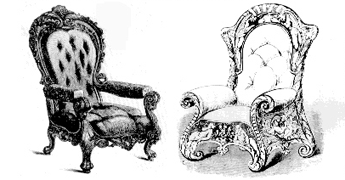|

Home
Up
| |
(Sample)
 When many people think of the term
Victorian, they envisage this kind of extremely ornate, even cluttered furniture proudly
shown at the 1851 Crystal Palace exhibition. During the decades of the twentieth century
when the stripped-down, supposedly functional aesthetic of High Modernism ruled, most
found it difficult to take seriously any Victorian furniture and design anything other
than the proto-modern work inspired by Ruskin and Morris. When many people think of the term
Victorian, they envisage this kind of extremely ornate, even cluttered furniture proudly
shown at the 1851 Crystal Palace exhibition. During the decades of the twentieth century
when the stripped-down, supposedly functional aesthetic of High Modernism ruled, most
found it difficult to take seriously any Victorian furniture and design anything other
than the proto-modern work inspired by Ruskin and Morris. Look at the way the designers
of this hideous furniture treat surface, overall design, and allusion and see how many
similarities you can discern between this still unfashionable work and the writings of,
say, Carlyle, Dickens, Elizabeth and Robert Browning, and Trollope. To begin with, what
are the literary analogues of surface embellishment in this furniture?
http://www.stg.brown.edu/projects/hypertext/landow/victorian/art/art5.html

|
"Architecture is two things: it is service and art. Hence the
tension between structure and appearance, function and form. Hence too the discord built
into that eternal triangle: commodity, firmness and delight. Therein -- at all times --
lies the architect's dilemma. But during the nineteenth century that dilemma was
compounded first by changing demands , secondly by
advancing technology, and thirdly by the whose phenomenon of historicism: the
multiplication of stylistic choice. The result was a crisis in confidence. In religion,
literature and philosophy the mid-Victorian period was an age of doubt. So too with
architecture: even the greatest Victorian architecture was shot through with uncertainty.
That uncertainty was thedilemma
of style."
J. Mordaunt Crook, The Dilemma of Style: Architectural Ideas from the Picturesque to
the Post-Modern (Chicago: University of Chicago Press, 1987), 98).

|
 etween the
decline of Palladianism and the rise of the Modern Movement, classical architecture in
England went through at least eight phases: etween the
decline of Palladianism and the rise of the Modern Movement, classical architecture in
England went through at least eight phases:
- Roman,
- Greek,
- Graeco-Roman,
- Italianate,
- Baroque,
- Mannerist,
- Beaux Arts and
- Neo-Georgian.
The first three -- Roman, Greek, and Graeco-Roman -- are late Georgian and Regency; the
fourth -- Italianate -- is early and mid-Victorian; and the last four -- Baroque,
Mannerist, Beaux Arts and Neo-Georgian are late Victorian and Edwardian.
These phases run parallel to the various stages of the Gothic Revival. Broadly
speaking, we call the first three Neo-Classical, and the other five Neo-Renaissance."
(J. Mordaunt Crook, The Dilemma of Style: Architectural Ideas from the Picturesque
to the Post-Modern, Chicago: University of Chicago Press, 1987, 193)
|
|